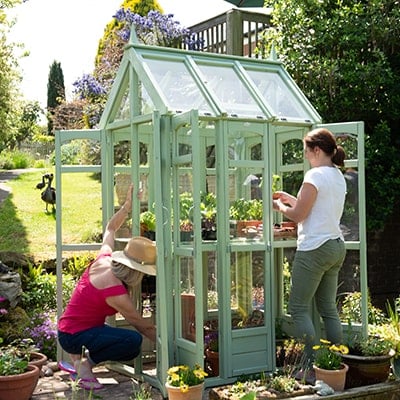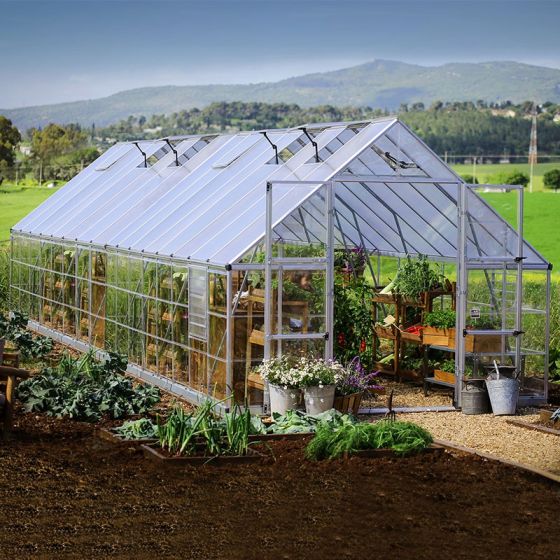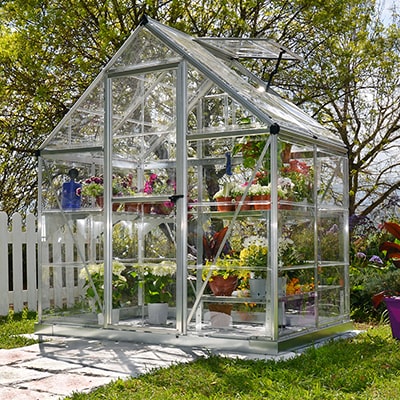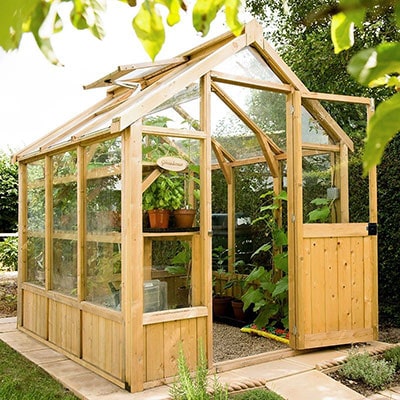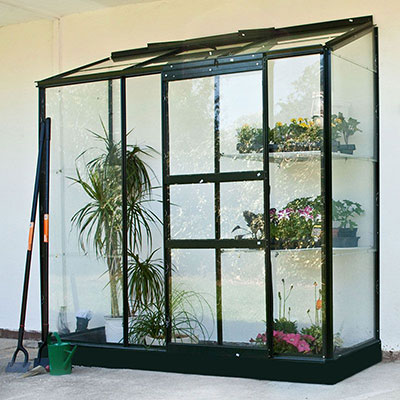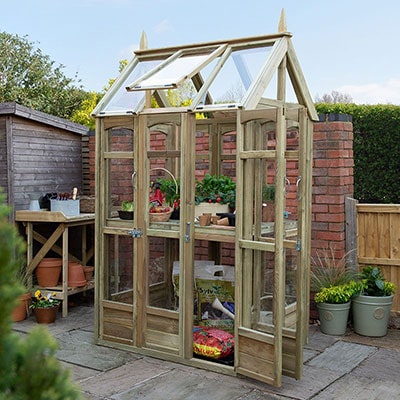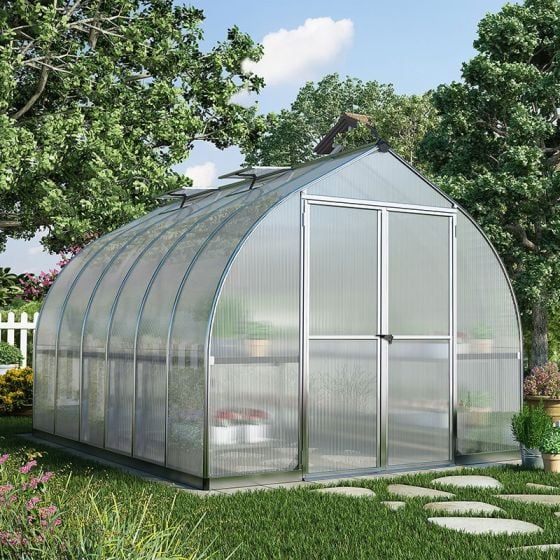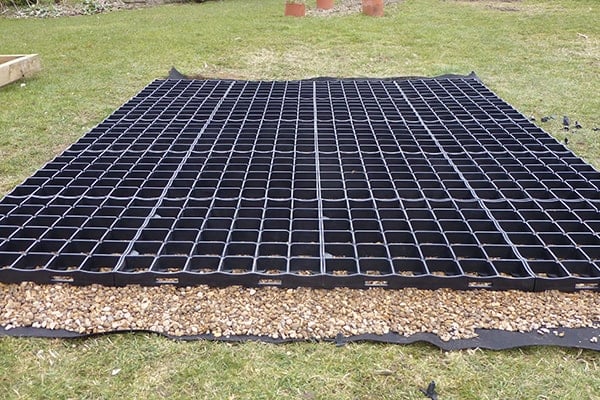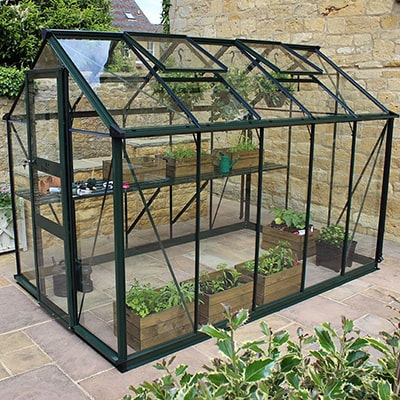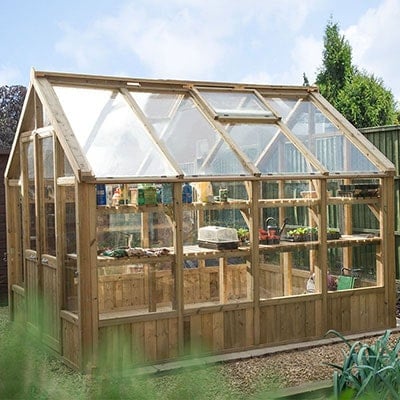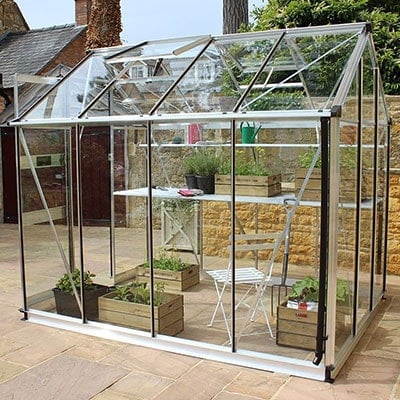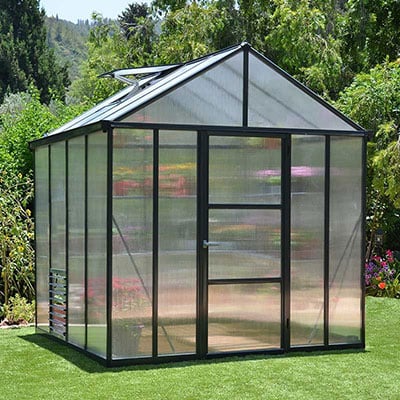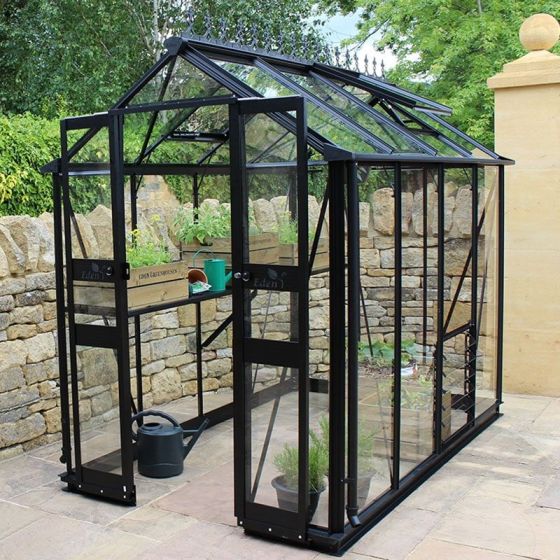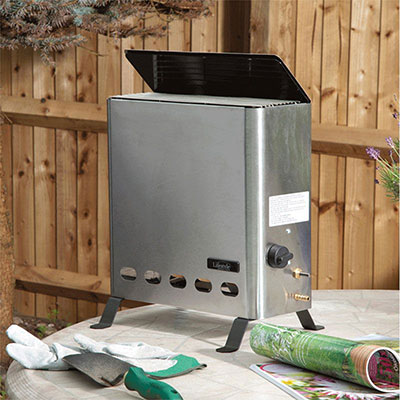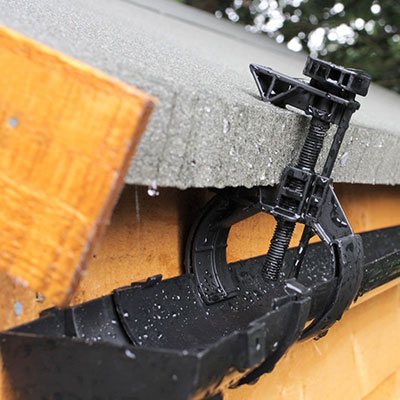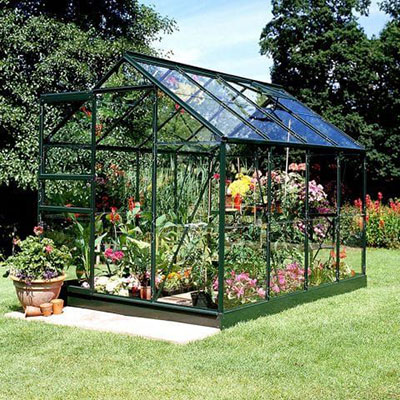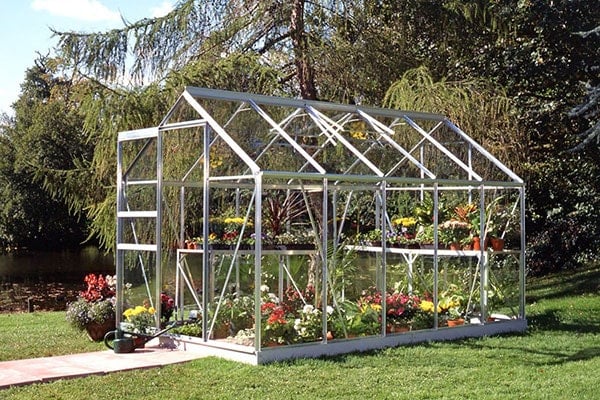
Buying a greenhouse is one of the best investments you’ll ever make for your garden. It offers you the chance to extend the growing season, increase your range of homegrown produce and cultivate and protect plants not normally suited to the British climate.
A greenhouse also makes an excellent focal point in the garden, a central hub in which to potter around and plan your yearly gardening tasks.
Editor’s Note [21.08.23]: Our original article about top 10 aspects to consider when buying a greenhouse was originally published on May 14, 2021. In this updated version we have expanded the answers with inclusion of sections about tall greenhouses, mini greenhouses and cold frames, greenhouse combi-sheds, galvanised steel bases as well as a significant upgrade to answer #8 about various aspects of greenhouse ventilation.
Greenhouse considerations – there are so many!
Depending on its size, a greenhouse can be a major financial investment. However, it is one which is worth every penny because it will bring you decades of enjoyment. With this in mind, you need to do your homework before choosing your ideal greenhouse so that you make the correct decision the first time around.
We don’t want you to be the person who looks at their newly assembled glasshouse and says, ‘If only I’d thought of that first’. We pay close attention to greenhouse features, as these play a vital role in choosing the perfect greenhouse for your needs.
This is why we’ve put together a comprehensive greenhouse buying guide, where we pose the 10 key questions that you need to ask yourself before purchasing your new greenhouse. There is invaluable information here for both beginners and experienced growers alike!
10 Questions to Ask Yourself Before Buying a Greenhouse
Before investing in a greenhouse, it is essential to contemplate numerous greenhouse considerations to ensure you choose the right model for your gardening needs. From determining the ideal size and location to considering the materials and additional features, this section will guide you through ten crucial questions that will help you make an informed decision about buying a greenhouse for your gardening endeavours.
1. What Sized Greenhouse Should I Buy?
The short answer to this question is the biggest greenhouse possible.
We’re yet to meet a keen gardener who wishes they didn’t own a bigger greenhouse. Gardening is as addictive as it is rewarding, and this means you’re going to fill your greenhouse quickly.
Of course, you’ll need to ensure that you have enough room for convenient access to your greenhouse, as well as maintain it. With the exception of lean to greenhouses (more of them later), it’s a good idea to leave at least the width of a wheelbarrow between the four sides of your greenhouse and any nearby walls (e.g., a garage wall), fencing, hedges and trees. This gives you more room to clean the glazing, treat the wood (if applicable) and carry out regular maintenance and repair work. Also, be mindful that doors and vents must be able to open freely.
Tall greenhouses (such as walk in greenhouses) are 6’ high and above and offer ample space for moving large items in and out, making them ideal for accommodating tall plants, gardening tools, and equipment. With their increased height, they provide a convenient solution for gardeners who require extra headroom and accessibility within the greenhouse space.
Deciding which size of your greenhouse to buy is one of the main greenhouse considerations. Try and assess as best as you can how much space you need. Once you’ve factored all that in and remembered to leave enough space for your other garden-based activities too, go large with your choice of greenhouse – the largest greenhouse you can.
2. Where Should I Position My Greenhouse?
Ideally, you should position your glasshouse in the part of your garden which enjoys the most hours of sunshine throughout the day. A sheltered spot away from high winds and cold prevailing wind is also a good idea.
Avoid placing a greenhouse near overhanging trees is crucial to ensure it receives sufficient direct sunlight and to prevent potential damage from falling branches or leaves. A row of trees though (at a sufficient distance away from the greenhouse) is a useful ally to withstand winds.
As touched on in the previous question, think about space too. Be sure that you can still comfortably tend to your hedges, trees, and plants. It’s no good buying a greenhouse only to neglect the other greenery in your garden.
If you have a smaller outside area, you’ll be particularly keen to position your glasshouse so that you can make the most of your garden space. This brings us nicely on to the next of our greenhouse considerations…
3. Which Greenhouse Design Should I Choose?
Most people consider there to be two main greenhouse designs: traditional and lean to.
Traditional Greenhouses
Traditionally shaped greenhouses (often called freestanding greenhouses) resemble most other garden buildings in that they are designed with four walls, and gables which lead up to an apex roof.
There are slight variations on this theme, of course, with some (usually larger) greenhouses having more rounded contours where the walls meet the roof, or even angled panels joining the two.
Traditional greenhouses look superb, as long as you have plenty of garden space.
Lean To Greenhouses
As the name suggests, lean to greenhouses are designed to lean or rest against a flat surface, usually an existing wall or fence. Lean tos have a pent-style roof which slopes downwards, away from this structure. A south facing house is beneficial for a lean-to greenhouse because it allows the greenhouse to receive maximum sunlight throughout the day.
Mini greenhouses and cold frames
A mini greenhouse is a practical and space-efficient solution for gardeners with limited space or those looking to grow crops and extend their growing season. Mini greenhouses and cold frames both provide protection against late frosts. They are ideal for delicate plants, seedlings, and summer crops, allowing you to nurture them even in colder weather conditions.
Of course, having both a cold frame and a greenhouse is common with many gardeners, as a cold frame is smaller and offers additional space to sow seeds and nurture plants in different stages of growth. This combination allows for greater flexibility and efficient use of more space in the garden.
Small greenhouses
Due to their space-saving designs, small greenhouses and lean to greenhouses are often popular with people who have smaller gardens. Large greenhouses, sunrooms, and resembling conservatories are big sellers too.
Greenhouses with Innovative Designs
The greenhouse world doesn’t completely revolve around traditional (freestanding greenhouse) models and lean to. There are plenty of innovative designs available, including hexagonal greenhouses and taller models with small footprints and multiple doors.
Again, these types of greenhouses are ideal if your garden space is at a premium.
4. Do I Need a Greenhouse Base?
We’ll come to the greenhouse base next because this is something you’ll need to organise before your greenhouse is delivered.
A greenhouse base is absolutely essential to the functionality and longevity of your greenhouse, so do not, under any circumstances, try and do without one.
The only thing you need to decide on is whether to build your own base, buy a readymade one or buy a greenhouse with an integral base.
Building A Greenhouse Base
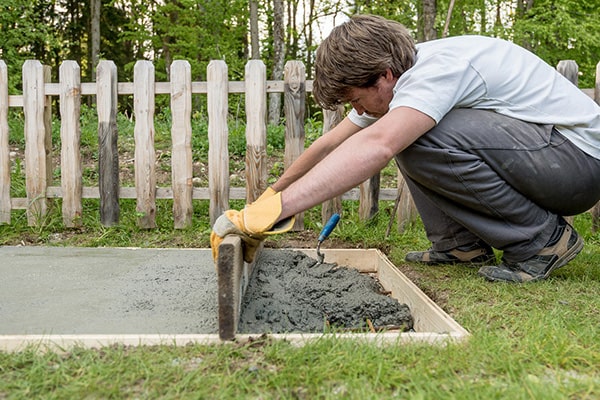

If you enjoy practical tasks, go for it…
It’s a good idea to raise your greenhouse base a few centimetres above ground level. This helps prevent ground moisture from damaging the frame and ensures the doors can open freely.
Concrete slabs, laid wet or dry, make a sound base as they are solid, level, and stable. They can also be watered in hot weather to add moisture to the greenhouse.
A galvanised steel base for greenhouses offers exceptional stability and durability, providing a solid foundation for your greenhouse structure. The corrosion-resistant properties of a metal base make it a long-lasting option, ensuring your greenhouse remains secure and protected for years to come.
Perimeter Bases
Some gardeners prefer a perimeter base only, which allows for planting the greenhouse directly in the ground inside the greenhouse. If you choose this option, be aware that rodents can burrow into the greenhouse.
Please note that perimeter bases are sometimes supplied with the greenhouse itself, so don’t go to any unnecessary trouble building one before you choose your new greenhouse. An example is the 8'x12' Palram Canopia Bella large walk in silver aluminium framed greenhouse, which has an integral perimeter metal base included within the price.
A brick plinth provides a solid and stable foundation for your greenhouse, adding an attractive aesthetic touch while elevating the structure for better drainage and protection against potential water damage.
Readymade Greenhouse Bases
We stock a wide range of readymade, plastic greenhouse base kits, available in all of the popular greenhouse size ranges. The obvious advantage of these bases is that they are far easier to lay than concrete slabs or paving slabs.
They consist of a heavy-duty membrane and interlocking plastic grid system, which should be filled with gravel. The end result is a highly effective and attractive base for any glasshouse.
5. Which Type of Greenhouse Frame Is Best?
The major choice for choosing between the best greenhouse frames for you is between aluminium and wood.
Aluminium Frames
The majority of modern greenhouses are supplied with an aluminium frame. The main advantages to metal frames are that they are lightweight, robust, durable, maintenance free and resistant to rust.
More often than not, greenhouse aluminium frames are silver in colour, although powder-coated finishes in green or black are becoming increasingly popular.
Aluminium greenhouses (often called metal greenhouses) generally have guarantees ranging from 5 to 12 years.
Wooden Greenhouses
The appeal of a wooden greenhouse is unmatched and filled with charm. They are incredibly attractive and their wooden frames blend in perfectly with the natural environment of a garden and suit traditional garden styles.
Of course, with wooden models, there’s the option to paint a wooden frame too and create a completely unique style to complement a particular theme in your garden.
Typically, our pressure-treated timber frames offer a 15-year anti-rot guarantee, so no further treatment is required, saving time and money. This makes them almost as low hassle as their aluminium counterparts.
Dip treated wooden greenhouses usually have a 10-year anti-rot guarantee but will require more maintenance and annual retreatment to validate the guarantee.
Considering the amount of glazing on a greenhouse, this process is usually a more time-consuming job than treating a shed. It is obviously something to think about carefully and reinforces our advice about leaving sufficient space to provide easy access to the entire perimeter of your greenhouse.
The one advantage of a dip-treated frame over a pressure-treated frame is that the greenhouse is normally cheaper.
6. Any Preference for Greenhouse Glazing?
There are four major choices for greenhouse glazing: horticultural glass, toughened glass, styrene, and polycarbonate.
Horticultural and Toughened Glass
Horticultural glass and toughened safety glass let in 90% of sunlight. With strong insulation properties, they are excellent at retaining heat, as they radiate heat back into the greenhouse, making greenhouse glass a highly efficient glazing option. Nevertheless, glass panels are relatively fragile compared to other materials, even if they are easily replaced.
So, if you want a real glasshouse and have a busy garden, particularly for children who enjoy ball games, we advise upgrading to toughened safety glass. It’s more expensive, yes, but toughened glass greenhouses receive more light and in the long run, are definitely worth it.
Styrene and Polycarbonate Greenhouse Glazing
Styrene is far lighter in weight than glass but incredibly tough; in fact, it is virtually unbreakable. This makes it a safer option for those of you with pets and children. Providing that it’s UV-stabilised, it will retain its crystal-clear appearance and will neither fade nor discolour in the sun. It’s a very good option.
Polycarbonate greenhouses come typically supplied with aluminium frames. Like styrene, the glazing is virtually shatterproof and completely UV-stabilised.
Its exact type and thickness can vary between greenhouses. Clear polycarbonate greenhouse panels are by far the most popular greenhouse model. Generally, thicker and/ or frosted polycarbonate glazing means slightly lower light transmission but will protect young plants particularly well. It offers protection from harmful UV rays and possesses excellent light-diffusing properties, preventing plants from getting scorched.
Light levels in polycarbonate greenhouses range between about 80 and 90%. Do not be influenced by the differences in these figures as all of our polycarbonate greenhouses are excellent buys.
7. What About the Greenhouse Doors?
The main choices here are between a single or double door, conventional or sliding opening, and whether or not to have a threshold bar.
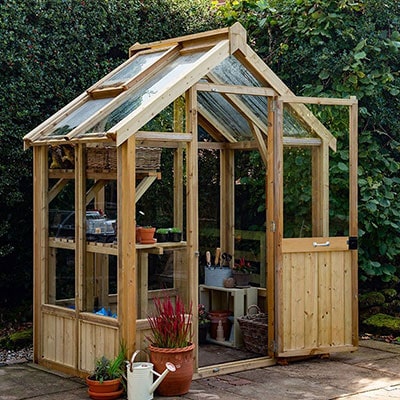

Single or Double Doors
For a small greenhouse, a single door will usually be adequate. Double doors tend to provide easier access, making it ideal for accommodating large potted plants, moving back and forth with a wheelbarrow, or if you’re a wheelchair user.
Sliding Doors
Sliding doors come into their own when your greenhouse is in a relatively confined space. Also, there’s no real danger of them blowing shut in windy conditions.
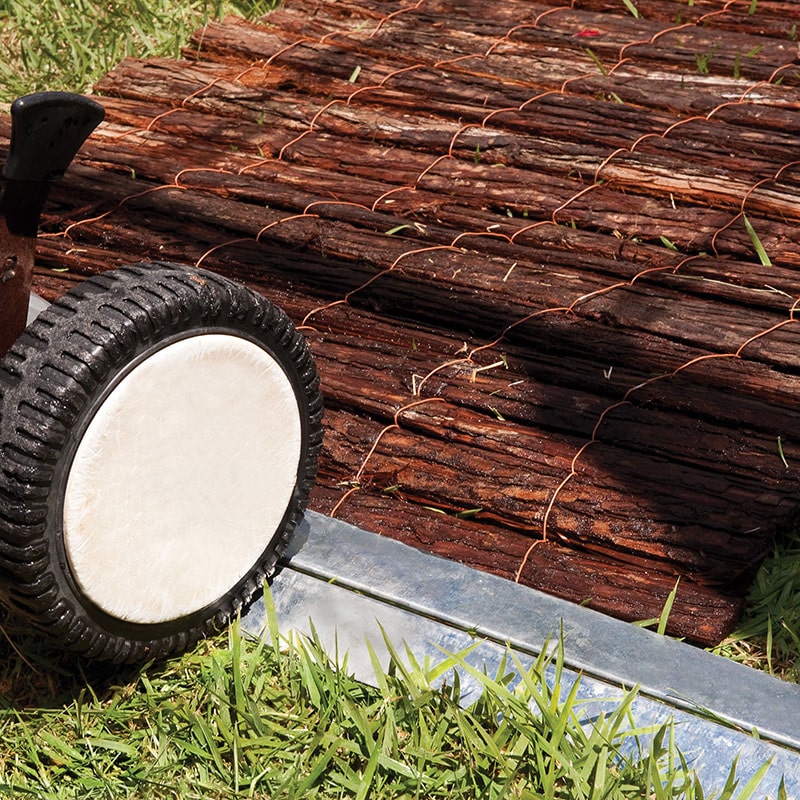

Threshold Bars
If you have mobility issues, particularly if you are a wheelchair user, you should opt for a greenhouse design without a threshold bar. This will give you easier, safer access to your greenhouse.
Lockable Doors
When choosing a greenhouse door, consider whether you need a lockable option to secure valuable garden tools and plants from potential theft. Lean to greenhouses or sunrooms with direct access from your home's back door may also benefit from a lockable door for added security.
8. Why Is Greenhouse Ventilation So Important?
In greenhouse gardening, ventilation is an important factor in maintaining a healthy and thriving environment for plants. The presence of vents and louvre windows enables gardeners to regulate temperature and airflow within the greenhouse. From manual vents that allow hands-on control to automatic vent openers that offer convenience, understanding the importance of greenhouse ventilation and the various options available is crucial for successful plant cultivation.
Vents and Louvre Windows
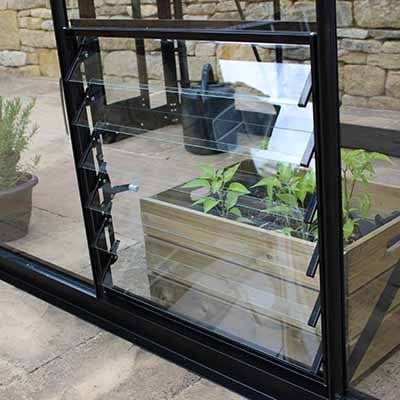

The vent is an essential part of a greenhouse because it allows you a degree of control over good ventilation and the temperature inside the greenhouse. There are various types of greenhouse vents, including roof vents, side vents, louvre vents, ridge vents, and automatic vent openers. Vents are generally located on the greenhouse roof, with louvre windows/ vents positioned on the side panels as an added bonus to provide good circulation.
In general, larger greenhouses tend to have more vents, although some smaller ones may still feature multiple vents or a vent and side louvre window, which is a notable advantage. When selecting a greenhouse, if all other factors are equal, it is advisable to opt for a model with as many vents as possible for the extra ventilation it brings.
Manual Vents
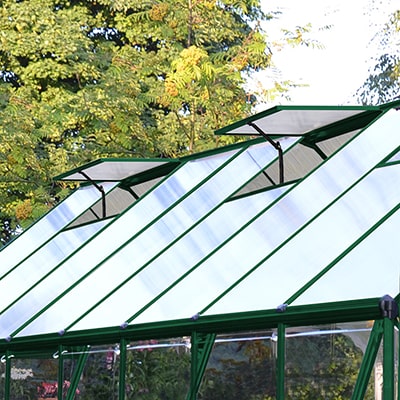

Manual vents are a crucial aspect of greenhouse ventilation, allowing gardeners to control the internal climate. On sunny days, it is essential to open doors and vents to prevent overheating and ensure proper airflow. Conversely, closing them at night helps to keep plants warm. Opening vents on one side is a popular tactic with many gardeners. Using a reliable thermometer (see question 10) assists in monitoring temperature fluctuations, enabling precise adjustments for optimal plant growth.
Automatic Vents
Another big decision you will need to make here is whether to pay the extra for auto vents.
As implied by its name, an automatic vent opener operates by automatically opening and closing in response to temperature changes inside the greenhouse. While not a necessity, automatic vents are a valuable feature, especially for individuals who are away from their greenhouse for extended periods during the day, ensuring that the greenhouse remains adequately ventilated even in their absence.
9. Do I Need Greenhouse Staging/Shelving?
Yes, you certainly want a greenhouse with staging and shelving.
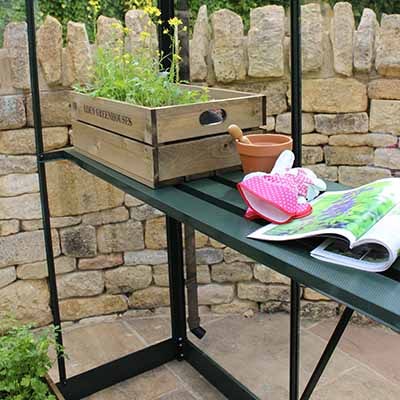

Greenhouse Staging
Staging is an essential component of a greenhouse which is specially designed to give you a raised surface on which to pot plants, care for them and engage in various other gardening-related activities.
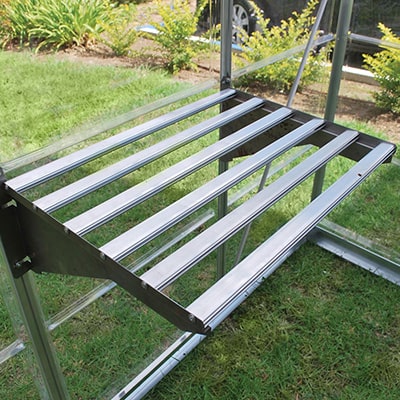

Greenhouse Shelves
Shelving is just as valuable since it enables you to optimise your greenhouse space. Without it, you would have less space and only be able to use the greenhouse floor.
Considering the need for compost, empty pots, hand tools, and overwintering tender plants a greenhouse lacking shelving would leave little space for growing plants.
Greenhouse combi-sheds
If extra storage space is what you need, we recommend you consider greenhouse combi-sheds. These are a versatile and stylish addition to any garden, offering both greenhouse space for cultivating plants and a separate storage shed for gardening tools and equipment. With its sturdy construction and attractive design, a combi-shed is perfect for gardeners who want the convenience of a greenhouse and shed in one unit. Our range has models ranging from 8’x6’ up to 12’x6’.
10. What Essential Greenhouse Accessories Should I Buy?
Regarding Temperature
Thermometers
To ensure you have a suitable growing environment for your tender plants, you need to be aware of the temperature. This makes a thermometer a must.
The ideal thermometer should not only display the current temperature but also show the daily minimum and maximum temperatures, offering a comprehensive overview of the greenhouse's temperature fluctuations. This helps you properly monitor, and so optimise, growing conditions throughout the day. This applies even when you’re not around and especially in winter weather.
Roller Blinds
The level of shading plays a big part in determining the temperature inside a greenhouse. There are a variety of ways to achieve this, roller blinds being one of them.
Blinds look great and can even be linked to a thermostat. Again, this allows you to grow plants in optimal conditions, even when away from the greenhouse.
Greenhouse Heaters
Despite the greenhouse's inherently warmer environment compared to the outside, there are numerous occasions all year round when tender plants require that extra boost of heat.
Greenhouse electric heaters and portable gas cabinet heaters are both effective at protecting plants.
Although your choice will probably be influenced by whether or not your greenhouse is connected to a power supply, a big advantage of gas heaters is their manoeuvrability.
It is worth mentioning that a lean to greenhouse benefits from increased thermal efficiency due to its shared wall, which can help regulate temperature fluctuations.
Regarding A Water Supply
Along with sufficient light and heat, plants need water. You shouldn’t have any problems supplying them with this, but consider the benefits of purchasing the following 3 greenhouse accessories:
Greenhouse Guttering
Some of the greenhouses within our range include integral gutters – problem solved.
If not, you would be well advised to purchase one.
We highly recommend using Hall's Rainsaver Guttering, which is available in various greenhouse sizes, is extremely simple to install, and includes all the necessary components to connect it to a water butt.
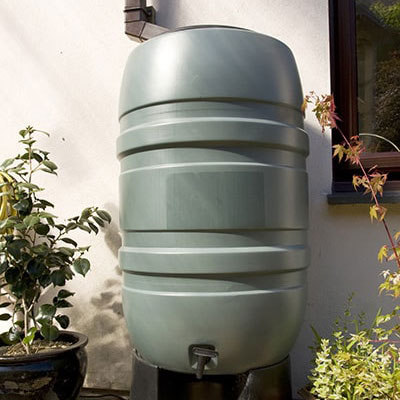

Water Butts
Harvesting rainwater with an external water butt provides numerous benefits to your plants. This sustainable and cost-free water source is far better for your plants compared to tap water, ensuring their optimal growth and health.
Water Tanks
A water tank in a greenhouse has two useful functions:
- To begin with, the water from a greenhouse water butt is slightly warmer than tap water, which helps prevent shocking your plants' delicate systems. This gentle temperature difference ensures a more favourable environment for their growth and well-being
- Additionally, the slight evaporation of the water from the greenhouse water butt will increase humidity levels inside the greenhouse and minimise water loss from your plants' leaves. This natural process aids in creating a more suitable and nurturing atmosphere for your plants' growth
In terms of the size of the greenhouse, it depends on how big your greenhouse is but even a small tank tucked into a corner, big enough to dip a watering can into, is a great addition…but don’t let it take up too much valuable growing space!
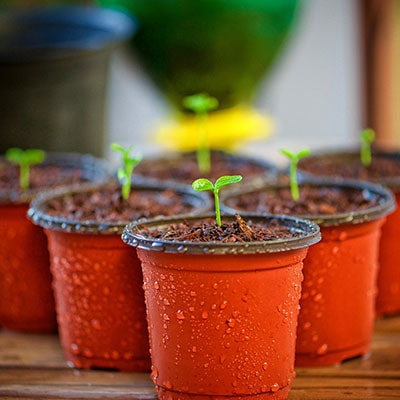

Pots and potting benches
You can never have too many pots. Young plants grow quickly and it’s important to give them a suitably sized home. A potting bench inside your greenhouse is a practical and convenient addition, offering a dedicated space for repotting plants, organising gardening tools, and preparing seedlings with ease.
Trellising Kits
Climbing plants are one of the most beautiful sights in a garden and there will be times when your young climbers need the protection of a greenhouse. A trellising kit is ideal for this purpose.
Once You’ve Chosen Your Greenhouse
Assembling Your Greenhouse
Once your new greenhouse has been delivered, choose a dry day to assemble it and start early.
For anything but the mini greenhouses and small greenhouses, it is a two-person job so enlist some help.
Lay out all of the parts, identify them and ensure you have the correct tools to hand. Once this is done, you can reasonably expect to own a fully functioning by the end of the day.
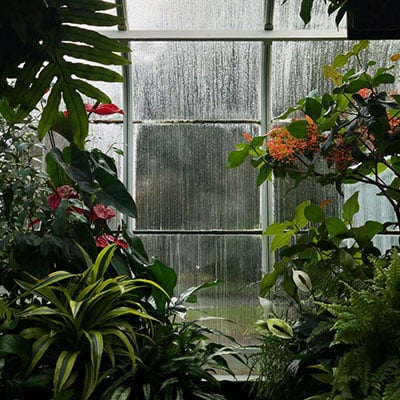

What to Grow?
And this is when the joys of greenhouse gardening properly begin: From all of us at Shedstore – happy gardening.
In conclusion
In conclusion, buying a greenhouse is a rewarding investment that extends the growing season, allows for a diverse range of homegrown produce, and protects plants in various climates. To make an informed decision, consider the greenhouse size, location, design, frame material, and glazing options.
Do not forget the importance of proper ventilation and essential accessories like staging, shelving, thermometers, and water supply systems. With careful consideration, your greenhouse will become a central hub for gardening and a source of endless joy and productivity.
We hope you've found this blog and our top tips informative and that it has made you feel more confident about choosing your dream greenhouse. When you're ready to make that choice, have a look through our full range of greenhouses for sale to find the greenhouse that's right for you.
Need More Help Choosing Your Greenhouse?
Our friendly, UK-based customer service team will be happy to answer any questions you have about buying a greenhouse as you mull through greenhouse considerations. Choose any of the main types of greenhouses from a mini greenhouse to a sunroom, we have everything you need! Contact Shedstore to discuss our best-selling greenhouses by telephone at 0333 003 0518, by live chat on the website, or by emailing us at [email protected].
Top image: 6'4 x 10'6 Halls Popular 106 Greenhouse





